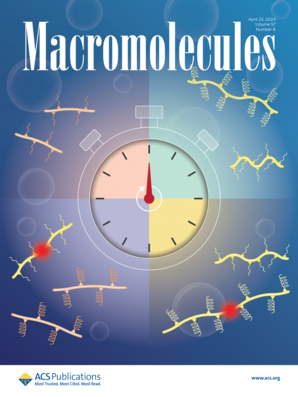Strengthening and Self-Reinforcement of Polyacrylamide/Chitosan Hydrogel through Salting-Out Treatment and Mechanical Training
IF 5.1
1区 化学
Q1 POLYMER SCIENCE
引用次数: 0
Abstract
Applications of hydrogels─such as in biomimetic artificial muscles─demand a high capacity for large deformation, exceptional strength, and unique self-reinforcement properties. However, designing hydrogels that combine all these attributes remains a challenge. In this work, we strengthen the polyacrylamide/chitosan composite hydrogel by employing a salting-out treatment. Subsequent mechanical training through cyclic loading induces self-reinforcement: when the external deformation exceeds the training deformation, i.e., the historical maximal stretch ratio, the hydrogel exhibits a higher stress compared to the case of monotonic loading. The mechanisms of strengthening and self-reinforcement were elucidated through a combination of mechanical experiments and molecular dynamics simulations. The strengthening of the hydrogel is attributed to the aggregation of chitosan chains, driven by both the shielding of electrostatic repulsion and hydrophobic association. Additionally, cyclic loading promotes the integration of residual dissociated chitosan chains into these aggregated chains, forming larger and stronger cluster domains that further reinforce the hydrogel. Moreover, hydrogels treated with a lower concentration of sodium chloride solution exhibited more pronounced self-reinforcement, a phenomenon effectively explained by the proposed physical picture. This work offers deeper insights into the mechanisms of hydrogel self-reinforcement and provides valuable guidance for designing hydrogels with superior self-reinforcement, thereby presenting a feasible method for developing soft biomimetic devices.

经盐析处理和机械训练的聚丙烯酰胺/壳聚糖水凝胶的强化与自强化
水凝胶的应用──例如在仿生人造肌肉──需要大变形的高容量、超强的强度和独特的自我增强特性。然而,设计出结合所有这些特性的水凝胶仍然是一个挑战。本文采用盐析法对聚丙烯酰胺/壳聚糖复合水凝胶进行了强化处理。通过循环加载进行后续的机械训练,引起水凝胶的自增强:当外部变形超过训练变形即历史最大拉伸比时,水凝胶的应力高于单调加载。通过力学实验和分子动力学模拟相结合的方法,阐明了强化和自我强化的机制。水凝胶的强化是由于壳聚糖链的聚集,在静电排斥和疏水结合的屏蔽作用下。此外,循环加载促进剩余解离的壳聚糖链整合到这些聚集链中,形成更大更强的簇结构域,进一步增强水凝胶。此外,用较低浓度的氯化钠溶液处理的水凝胶表现出更明显的自我强化,这一现象有效地解释了所提出的物理图景。本研究对水凝胶的自增强机理有了更深入的认识,为设计具有优异自增强性能的水凝胶提供了有价值的指导,从而为开发柔性仿生装置提供了一种可行的方法。
本文章由计算机程序翻译,如有差异,请以英文原文为准。
求助全文
约1分钟内获得全文
求助全文
来源期刊

Macromolecules
工程技术-高分子科学
CiteScore
9.30
自引率
16.40%
发文量
942
审稿时长
2 months
期刊介绍:
Macromolecules publishes original, fundamental, and impactful research on all aspects of polymer science. Topics of interest include synthesis (e.g., controlled polymerizations, polymerization catalysis, post polymerization modification, new monomer structures and polymer architectures, and polymerization mechanisms/kinetics analysis); phase behavior, thermodynamics, dynamic, and ordering/disordering phenomena (e.g., self-assembly, gelation, crystallization, solution/melt/solid-state characteristics); structure and properties (e.g., mechanical and rheological properties, surface/interfacial characteristics, electronic and transport properties); new state of the art characterization (e.g., spectroscopy, scattering, microscopy, rheology), simulation (e.g., Monte Carlo, molecular dynamics, multi-scale/coarse-grained modeling), and theoretical methods. Renewable/sustainable polymers, polymer networks, responsive polymers, electro-, magneto- and opto-active macromolecules, inorganic polymers, charge-transporting polymers (ion-containing, semiconducting, and conducting), nanostructured polymers, and polymer composites are also of interest. Typical papers published in Macromolecules showcase important and innovative concepts, experimental methods/observations, and theoretical/computational approaches that demonstrate a fundamental advance in the understanding of polymers.
 求助内容:
求助内容: 应助结果提醒方式:
应助结果提醒方式:


